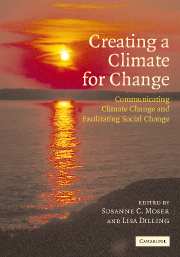Book contents
- Frontmatter
- Contents
- Preface
- Foreword
- List of contributors
- List of tables
- List of figures
- List of text boxes
- Introduction
- Part I Communicating climate change
- 1 Weather or climate change?
- 2 Communicating the risks of global warming: American risk perceptions, affective images, and interpretive communities
- 3 More bad news: the risk of neglecting emotional responses to climate change information
- 4 Public scares: changing the issue culture
- 5 The challenge of trying to make a difference using media messages
- 6 Listening to the audience: San Diego hones its communication strategy by soliciting residents' views
- 7 The climate-justice link: communicating risk with low-income and minority audiences
- 8 Postcards from the (not so) frozen North: talking about climate change in Alaska
- 9 Climate change: a moral issue
- 10 Einstein, Roosevelt, and the atom bomb: lessons learned for scientists communicating climate change
- 11 Across the great divide: supporting scientists as effective messengers in the public sphere
- 12 Dealing with climate change contrarians
- 13 A role for dialogue in communication about climate change
- 14 Information is not enough
- Part II Facilitating social change
- Part III Creating a climate for change
- About the authors
- Index
- References
6 - Listening to the audience: San Diego hones its communication strategy by soliciting residents' views
Published online by Cambridge University Press: 20 August 2009
- Frontmatter
- Contents
- Preface
- Foreword
- List of contributors
- List of tables
- List of figures
- List of text boxes
- Introduction
- Part I Communicating climate change
- 1 Weather or climate change?
- 2 Communicating the risks of global warming: American risk perceptions, affective images, and interpretive communities
- 3 More bad news: the risk of neglecting emotional responses to climate change information
- 4 Public scares: changing the issue culture
- 5 The challenge of trying to make a difference using media messages
- 6 Listening to the audience: San Diego hones its communication strategy by soliciting residents' views
- 7 The climate-justice link: communicating risk with low-income and minority audiences
- 8 Postcards from the (not so) frozen North: talking about climate change in Alaska
- 9 Climate change: a moral issue
- 10 Einstein, Roosevelt, and the atom bomb: lessons learned for scientists communicating climate change
- 11 Across the great divide: supporting scientists as effective messengers in the public sphere
- 12 Dealing with climate change contrarians
- 13 A role for dialogue in communication about climate change
- 14 Information is not enough
- Part II Facilitating social change
- Part III Creating a climate for change
- About the authors
- Index
- References
Summary
A city synonymous with its climate
In a city that calls its climate “perfect,” where the coastline includes miles of America's most beautiful beaches, where temperatures are high almost all year round and annual total rainfall inches are measured in single digits, concern about the dangers of climate disruption seem out of place. Can laid-back Southern Californians even relate to the threat of global warming, much less take action?
In fact, San Diego's enviable climate makes it a particularly apt setting for civic discussions about climate change. Two of the area's most important economic activities – tourism and agriculture – rely on the exceptional climate to continue flourishing, yet are vulnerable to rising temperatures. A growing population puts increasing pressure on energy and water, resources that are primarily imported from far away. Attention to climate issues will be essential to sustaining the city's celebrated quality of life, including the availability of fresh air, clean water, and affordable utilities. Shifting temperature and rainfall may lead to a significant decrease in agricultural products and may diminish the region's desirability as a tourist destination.
Moreover, the global threat is not remote at all. Climate change at the local level is already well documented. The region's average temperature has been increasing over the past century, and the number of days with temperatures above 100 degrees Fahrenheit (38 °C) has risen even more sharply.
- Type
- Chapter
- Information
- Creating a Climate for ChangeCommunicating Climate Change and Facilitating Social Change, pp. 105 - 118Publisher: Cambridge University PressPrint publication year: 2007
References
- 2
- Cited by



